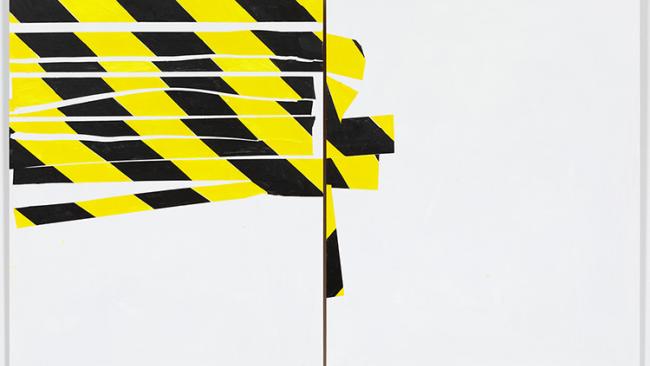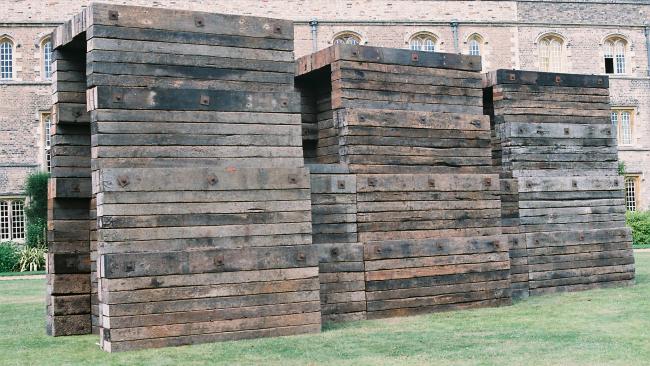
Anthony Caro
Works exhibited: Dark Motive, Sailing Tonight, Silk Road, Babylon.
Sir Anthony Caro is widely acknowledged as the most influential British sculptor of the postwar period. After two years as an assistant to Henry Moore in the early 1950s, he began working at St Martin’s School of Art, where his teaching had an indelible effect on the following generation of artists.
He began producing abstract sculptures at the beginning of the 1960s, showing fifteen largescale works at the Whitechapel Gallery in 1963, in an exhibition that has since acquired legendary status. His work has remained at the forefront of critical attention ever since.
"I never want people to handle my sculpture, to run their hands over surfaces. But I do want them to grasp it in a physical way, to relate to it with their bodies: that is one reason why the early works were so big.
It is as if the eyes become a surrogate for the body. In one way or another physicality has to be a part of sculpture. Looking is physical, not conceptual: you never get the full sense of a sculpture from a photograph. The artwork is a real thing; even if you do not lift it, you have to be aware of real size, real weight."
His work of the 1970s, represented here by Silk Road, Sailing Tonight, and Dark Motive, is sharply focused, spare in expression, conjuring shape and form out of a minimum of sculptural elements.
Their anecdotal titles are belied by the self reflexiveness of these works that articulate nothing except the space that they frame with slender verticals and horizontals.
The evocativeness of travel and the hints of psychological complexity attached to the names fail to take hold of the sculptures themselves which allude only to one another in their formal concentration on the language of sculpture.
The legerity of these constructions in steel, which seem to have convinced themselves of their own weightlessnes, is characteristic of Caro’s spirit of enquiry, his resourcefulness in making his materials perform a variety of functions.
The harder and heavier these are, the more they seem able to contradict their own properties. These works are also signature pieces in their abandonment of the plinth. The idea that sculpture should sit directly on the ground, without creating a space for itself beyond that of the viewer, is now a commonplace but was first put into regular practice by Caro.
There is an immediacy in the appeal of these elegant improvisations, giving them an impromptu flourish, as if they have been rapidly conceived before being meticulously elaborated. One of Caro’s earliest critics, Michael Fried, has written "One can imagine a gifted dancer dancing one of Caro’s sculptures," a remark which captures both the playfulness of Caro’s use of materials and his concentration on the management of space. One can certainly imagine the sculptor regarding his task as a choreographing of the relations between work and viewer. Perhaps the most direct expression of this tendency in Caro’s work was his decision in the late 1970s to build hybrid works between sculpture and architecture that took the form of towers viewers could enter and explore.
By the 1990s, Caro seem to have emerged from his virtuosic encounters with the scope of form, space and materials to produce a number of large structures with a more consistently architectural ambition. At the same time, his work began to show more interest in quoting from cultural history, especially from prehistory and antiquity, as if in search of the imagined origins of certain traditions, of the founding moments of ways of being in the world, and of seeing it, that might have taken a different direction.
Babylon falls squarely into this category. If the earlier work seems often to retain the imprint of a fresh thought, the larger scale cellular installations of the last 15 years seem to carry a freight of knowledge that extends into other disciplines and practices. The three massively constructed units of Babylon recall the stepped design of ancient Sumerian ziggurats. These are among the earliest forms of monumental architecture and form the basis of artistic imaginings of the appearance of the Tower of Babel.
Another work from 2001, Tower, first shown at Goodwood Sculpture Park, addresses aspects of the same myth, but uses a more open, scaffold like design, with the addition of plates of steel that make the whole work look larger at the top than at the base. This amounts almost to an inversion of the pyramidal structure of the ziggurat. The construction of the mythical Tower of Babel was the prelude to the loss of a universal language, to a decline into anarchy and divergent linguistic traditions.
Caro’s work evokes a moment in cultural history in which art and architecture seem to propose a language that can bind together disparate sensibilities in a common experience of spatial organisation. But it is also a reminder of the early history of urban civilisation, of the gradual move towards inhabiting an increasingly manmade environment, with its history of successive and conflicting styles and designs; with its intensifying competition for the same space.
This tripartite sculpture is itself the product of a polyglot reality, of an eclectic postmodernity: constructed in Britain as an allusion to ancient Babylon, it is comprised of sections of Jarrah wood imported from Australia. Jarrah is used all over the world to provide sleepers for thousands of miles of railway track, and contributes in this way to the material embodiment of a technology and a culture that is nearly universal.
Caro’s use of railway ties separates the material from its conventional function in order to stress its symbolic unitary value in a work that simultaneously recalls cultural diversity. It is in the tension between universal and multifarious traditions that sculpture reflects the true condition in which to construct a sense of identity and relationship.
